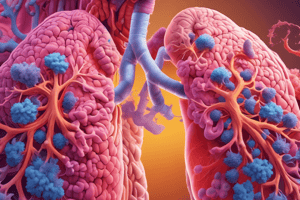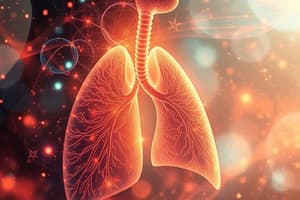Podcast
Questions and Answers
What is pleurodesis used for?
What is pleurodesis used for?
- To prevent recurrent pneumothoraces (correct)
- To diagnose pleural effusion
- To treat tuberculosis
- To remove fluid from the pleural space
What is a significant physical exam finding in pleural effusion?
What is a significant physical exam finding in pleural effusion?
- Wheezing breath sounds
- Increased tactile fremitus
- Wet cough
- Dullness to percussion (correct)
Which of the following conditions can cause pleural effusion?
Which of the following conditions can cause pleural effusion?
- Asthma exacerbation
- Liver cirrhosis
- Chronic bronchitis
- Left heart failure (correct)
Barotrauma leading to pneumothorax can occur due to what activity?
Barotrauma leading to pneumothorax can occur due to what activity?
Meigs syndrome is characterized by which triad?
Meigs syndrome is characterized by which triad?
What is the primary management strategy for an acute asthma attack?
What is the primary management strategy for an acute asthma attack?
Which medication should be commenced for a patient with asthma who has had 2 or more episodes per week?
Which medication should be commenced for a patient with asthma who has had 2 or more episodes per week?
What is the most common cause of bronchiectasis in western countries?
What is the most common cause of bronchiectasis in western countries?
What does the presence of 'cups and cups of foul-smelling sputum' indicate in patients with bronchiectasis?
What does the presence of 'cups and cups of foul-smelling sputum' indicate in patients with bronchiectasis?
What imaging finding is characteristic of bronchiectasis?
What imaging finding is characteristic of bronchiectasis?
Why should inhaled corticosteroids be prescribed at discharge for an asthma patient who required hospitalization?
Why should inhaled corticosteroids be prescribed at discharge for an asthma patient who required hospitalization?
What misconception might students have regarding initial asthma therapy for patients with frequent episodes?
What misconception might students have regarding initial asthma therapy for patients with frequent episodes?
What condition is least likely to cause bronchiectasis?
What condition is least likely to cause bronchiectasis?
What notable skin change is associated with cholesterol embolism following an abdominal aortic aneurysm (AAA) repair?
What notable skin change is associated with cholesterol embolism following an abdominal aortic aneurysm (AAA) repair?
Which of the following is a characteristic found in a cholesterol embolism under polarized light?
Which of the following is a characteristic found in a cholesterol embolism under polarized light?
What is often required to diagnose pulmonary contusion after trauma?
What is often required to diagnose pulmonary contusion after trauma?
Which of the following descriptions is typically NOT associated with pulmonary contusion?
Which of the following descriptions is typically NOT associated with pulmonary contusion?
In the context of a traumatic injury, what is a significant sign of flail chest?
In the context of a traumatic injury, what is a significant sign of flail chest?
Which condition could potentially be confused with pulmonary contusion if rib fractures are present?
Which condition could potentially be confused with pulmonary contusion if rib fractures are present?
What is the primary treatment recommended for sarcoidosis presenting as lupus pernio?
What is the primary treatment recommended for sarcoidosis presenting as lupus pernio?
What type of lung finding can be described as ‘white-out’ in typical references, although not common on exams?
What type of lung finding can be described as ‘white-out’ in typical references, although not common on exams?
What may suggest a worsening condition if a patient with pulmonary contusion receives IV saline?
What may suggest a worsening condition if a patient with pulmonary contusion receives IV saline?
Which condition is most commonly associated with pulmonary fibrosis in patients with rheumatoid arthritis?
Which condition is most commonly associated with pulmonary fibrosis in patients with rheumatoid arthritis?
What is the most common ECG finding indicative of pulmonary embolism?
What is the most common ECG finding indicative of pulmonary embolism?
Which of the following is the first step in managing a suspected pulmonary embolism?
Which of the following is the first step in managing a suspected pulmonary embolism?
In pregnant patients suspected of having a pulmonary embolism, which diagnostic test is preferred over CT?
In pregnant patients suspected of having a pulmonary embolism, which diagnostic test is preferred over CT?
What is the most common cause of death from pulmonary embolism?
What is the most common cause of death from pulmonary embolism?
What acid-base disturbance is typically observed in patients with acute pulmonary embolism?
What acid-base disturbance is typically observed in patients with acute pulmonary embolism?
In a patient already on warfarin who develops a pulmonary embolism, what is the first step for diagnosis?
In a patient already on warfarin who develops a pulmonary embolism, what is the first step for diagnosis?
Which of the following is the most common cause of fever within 24 hours post-surgery?
Which of the following is the most common cause of fever within 24 hours post-surgery?
What does the term 'atelectasis' refer to?
What does the term 'atelectasis' refer to?
In cystic fibrosis (CF), what is the more accurate diagnostic test compared to genotyping?
In cystic fibrosis (CF), what is the more accurate diagnostic test compared to genotyping?
What condition can male patients with cystic fibrosis have that affects their fertility?
What condition can male patients with cystic fibrosis have that affects their fertility?
What is the chance that a phenotypically normal sibling of a cystic fibrosis patient is a carrier of the disease?
What is the chance that a phenotypically normal sibling of a cystic fibrosis patient is a carrier of the disease?
Which of the following CF medications aids with structural folding and localization of CFTR to the cell membrane?
Which of the following CF medications aids with structural folding and localization of CFTR to the cell membrane?
What is the function of dornase-alfa in cystic fibrosis treatment?
What is the function of dornase-alfa in cystic fibrosis treatment?
Which of these statements about cystic fibrosis is true?
Which of these statements about cystic fibrosis is true?
What is the significance of early-onset emphysema and cirrhosis in a patient who smokes or consumes alcohol?
What is the significance of early-onset emphysema and cirrhosis in a patient who smokes or consumes alcohol?
Which type of asthma primarily presents with a dry cough without breathing difficulties?
Which type of asthma primarily presents with a dry cough without breathing difficulties?
What is the mechanism behind aspirin-induced asthma?
What is the mechanism behind aspirin-induced asthma?
What does the term 'increased expiratory phase' indicate?
What does the term 'increased expiratory phase' indicate?
What occurs acutely during an asthma attack in terms of blood gas levels?
What occurs acutely during an asthma attack in terms of blood gas levels?
What is a key characteristic of patients with Samter triad?
What is a key characteristic of patients with Samter triad?
Why is bicarbonate unchanged during an acute asthma attack?
Why is bicarbonate unchanged during an acute asthma attack?
In chronic obstructive pulmonary disease (COPD), what happens to CO2 levels?
In chronic obstructive pulmonary disease (COPD), what happens to CO2 levels?
Flashcards
Asthma
Asthma
A chronic lung disease characterized by inflammation and narrowing of the airways, leading to difficulty breathing, wheezing, coughing, and chest tightness.
Cough-variant asthma
Cough-variant asthma
Characterized by a dry cough, often worsening in winter, without significant breathing difficulties.
Aspirin-induced asthma
Aspirin-induced asthma
Asthma triggered by aspirin or other NSAIDs.
Samter triad
Samter triad
Signup and view all the flashcards
Lupus Pernio
Lupus Pernio
Signup and view all the flashcards
Increased expiratory phase
Increased expiratory phase
Signup and view all the flashcards
Rheumatoid Lung
Rheumatoid Lung
Signup and view all the flashcards
Acute respiratory alkalosis in asthma
Acute respiratory alkalosis in asthma
Signup and view all the flashcards
Emphysema and asthma
Emphysema and asthma
Signup and view all the flashcards
Pulmonary Embolism (PE)
Pulmonary Embolism (PE)
Signup and view all the flashcards
Treatment for Lupus Pernio
Treatment for Lupus Pernio
Signup and view all the flashcards
FEV1
FEV1
Signup and view all the flashcards
First-line treatment for Rheumatoid Arthritis
First-line treatment for Rheumatoid Arthritis
Signup and view all the flashcards
First-line management of PE
First-line management of PE
Signup and view all the flashcards
Investigation of choice for PE
Investigation of choice for PE
Signup and view all the flashcards
Most common ECG finding for PE
Most common ECG finding for PE
Signup and view all the flashcards
Atelectasis
Atelectasis
Signup and view all the flashcards
Cystic Fibrosis (CF)
Cystic Fibrosis (CF)
Signup and view all the flashcards
Sweat chloride test
Sweat chloride test
Signup and view all the flashcards
Congenital Bilateral Absence of Vas Deferens (CBAVD)
Congenital Bilateral Absence of Vas Deferens (CBAVD)
Signup and view all the flashcards
Ivacaftor
Ivacaftor
Signup and view all the flashcards
Dornase-alfa
Dornase-alfa
Signup and view all the flashcards
Guaifenesin
Guaifenesin
Signup and view all the flashcards
Carrier probability for siblings of CF patients
Carrier probability for siblings of CF patients
Signup and view all the flashcards
Inhaled corticosteroids (ICS) for asthma
Inhaled corticosteroids (ICS) for asthma
Signup and view all the flashcards
Acute asthma management
Acute asthma management
Signup and view all the flashcards
Discharge management for hospitalized asthma patients
Discharge management for hospitalized asthma patients
Signup and view all the flashcards
Asthma management for 2+ episodes weekly
Asthma management for 2+ episodes weekly
Signup and view all the flashcards
Bronchiectasis
Bronchiectasis
Signup and view all the flashcards
Causes of bronchiectasis
Causes of bronchiectasis
Signup and view all the flashcards
Bronchiectasis and smoking
Bronchiectasis and smoking
Signup and view all the flashcards
Bronchiectasis and right middle lobe syndrome
Bronchiectasis and right middle lobe syndrome
Signup and view all the flashcards
Cholesterol Embolism
Cholesterol Embolism
Signup and view all the flashcards
Cholesterol Embolism Symptoms
Cholesterol Embolism Symptoms
Signup and view all the flashcards
Maltese Cross
Maltese Cross
Signup and view all the flashcards
Flail Chest
Flail Chest
Signup and view all the flashcards
Pulmonary Contusion
Pulmonary Contusion
Signup and view all the flashcards
Fluid-Sensitive Pulmonary Contusion
Fluid-Sensitive Pulmonary Contusion
Signup and view all the flashcards
Myocardial Contusion
Myocardial Contusion
Signup and view all the flashcards
Post-Trauma Respiratory Distress
Post-Trauma Respiratory Distress
Signup and view all the flashcards
Pleurodesis
Pleurodesis
Signup and view all the flashcards
Pleural Effusion
Pleural Effusion
Signup and view all the flashcards
Hydrothorax
Hydrothorax
Signup and view all the flashcards
Meigs Syndrome
Meigs Syndrome
Signup and view all the flashcards
Pulmonary Barotrauma
Pulmonary Barotrauma
Signup and view all the flashcards
Study Notes
Asthma
- USMLE questions may include smokers or alcohol drinkers. Early-onset emphysema and cirrhosis are increased risks with smoking/alcohol use. Typically, COPD takes 20+ years of smoking to develop.
- Bronchospasm can be idiopathic, hereditary, or triggered by allergens or cold air.
- Cough-variant asthma is a presentation where the patient only has a dry cough, with no other breathing problems. These coughs are often worse in winter.
- Asthma can be part of a larger constellation of atopic symptoms, such as seasonal allergies, conjunctivitis, or eczema.
- Aspirin-induced asthma involves inhibition of COX by aspirin, leading to an increase in leukotrienes and bronchoconstriction. The Samter triad includes aspirin allergy, asthma, and nasal polyps.
- Increased expiratory phase is a descriptor not specific to asthma, but common in obstructive lung diseases. Exhaling takes longer with asthma (↓ FEV1).
- Respiratory alkalosis during an acute asthma attack is characterized by decreased CO2 and increased pH; Bicarbonate remains stable initially.
- Type I respiratory failure, or acute asthma attacks, present with decreased CO2, and increased pH. Low pH and CO2 are followed by a return to normal as the patient tires. The patient will then transition to type II respiratory failure (hypoventilation): increased CO2, and decreased O2.
- Spirometric testing (the primary initial diagnostic test) shows a concave expiratory portion of the curve.
- Methacholine challenges can be performed for diagnosis. These agonists trigger bronchoconstriction and can be used between acute episodes.
- Outpatient asthma management often includes beta2-agonists (albuterol) for acute attacks, followed by increasing ICS dose, LABA (salmeterol) if necessary, and other medications for continued episodes or poor response. Oral prednisone is a last resort for outpatient management.
- Inhaled corticosteroids are critical for long-term management
Bronchiectasis
- Bronchiectasis is most common worldwide due to TB, and in western countries, CF. It often presents with increased amounts of foul-smelling sputum.
- Common in smokers.
- Bronchiectasis can be a consideration in a child with right middle lobe syndrome and scant white sputum.
- Clubbing of the fingernails is a possible characteristic.
Atelectasis
- Atelectasis, or lung collapse, is a common cause of fever within 24 hours of surgery.
- Patient pain and sedation contribute to slower, shallow breathing, and hence alveoli collapse.
- Present as opacities or shadows in the lower lung fields, usually in bibasilar areas.
Obstructive Sleep Apnea (OSA)
- OSA includes obstructive (due to obesity) or central (due to brain) forms.
- Its primary symptom is respiratory acidosis (decreased pH, decreased bicarbonate, increased CO2)
- Cor pulmonale and pulmonary hypertension can be secondary complications.
- Sleep study (polysomnography) is crucial for diagnosis
Anaphylaxis
- Acute dyspnea and bilateral wheezing is characteristic.
- Frequently triggered by bee stings, certain foods (peanuts,), or new medications.
- Signs include: tachycardia, low blood pressure, and often generalized inflammation.
- Intramuscular epinephrine is the first-line treatment.
- Venom immunotherapy can prevent future reactions.
Shellfish Allergy
- Shellfish reactions can resemble asthma.
- Reactions occur immediately after consumption of shellfish.
Cystic Fibrosis
- Genetic disorder where defective CFTR protein leads to mucous accumulation.
- Inspissated secretions cause obstructive lung complications.
- Patients display exocrine pancreatic insufficiency and fat-soluble vitamin deficiencies (often vitamin E deficiency).
- Key presentations include meconium ileus, nasal polyps, and recurrent pneumonia associated with bacterial infections, especially Pseudomonas and S. aureus
- Sweat chloride testing is more reliable than genetic testing.
- Male patients may present with congenital bilateral absence of the vas deferens (CBAVD).
Primary Ciliary Dyskinesia (Kartagener Syndrome)
- Inherited disorder impacting cilia function, leading to recurrent infections and potential situs inversus (reversed organ placement). This diagnosis is suggested by the presence of a 'kartagener syndrome' or 'reversed organ placement' in patients with recurrent pneumonias.
- Situs inversus means the organs are on the opposite side of the body.
Primary Pulmonary Hypertension (PPH)
- Idiopathic disorder characterized by elevated pulmonary vascular resistance and hypertension.
- High endothelin-1 levels are frequently observed.
- PPH is distinguished from cor pulmonale (right sided heart failure) in that the cause of the hypertension is pulmonary versus a circulatory (systemic) origin.
Systemic Sclerosis (Scleroderma)
- Autoimmune condition marked by multi-organ fibrosis and hardening.
- Divided into limited (CREST) and diffuse subtypes.
- Pulmonary fibrosis and hypertension are significant complications.
- Treatment focuses on managing symptoms and complications.
Sarcoidosis
- A granulomatous disease with non-caseating granulomas in multiple organs.
- It often involves the lungs, leading to progressive lung fibrosis.
- A feature of note is elevated levels of 1,25-dihydroxyvitamin D and low PTH (parathyroid hormone), due to dysregulation of the 1-alpha hydroxylase enzyme. The elevated 1,25-dihydroxyvitamin D has systemic effects including elevated serum calcium.
- High suspicion for sarcoidosis if an African-American woman presents with a 6+ month cough, red shins (erythema nodosum), and low-grade fever.
- Characteristic findings are often hilar lymphadenopathy on chest X-ray or CT.
Rheumatic Lung
- Rheumatoid arthritis can lead to restrictive lung disease, and methotrexate, a DMARD commonly used to treat RA, may increase risk of pulmonary fibrosis.
Pulmonary Embolism (PE)
- PE results from a detached thrombus (usually from a deep vein thrombosis) traveling to the lungs.
- Patients commonly present with pleuritic chest pain, dyspnea, and tachycardia.
- Chest CT scan is the usual method to assess for PE.
- Initial treatment for PE is heparin followed by CT-imaging.
Studying That Suits You
Use AI to generate personalized quizzes and flashcards to suit your learning preferences.




